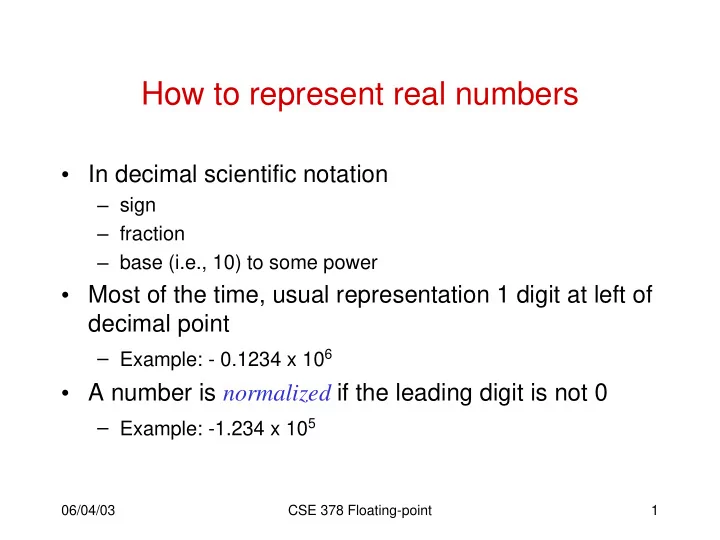

How to represent real numbers • In decimal scientific notation – sign – fraction – base (i.e., 10) to some power • Most of the time, usual representation 1 digit at left of decimal point – Example: - 0.1234 x 10 6 • A number is normalized if the leading digit is not 0 – Example: -1.234 x 10 5 06/04/03 CSE 378 Floating-point 1
Real numbers representation inside computer • Use a representation akin to scientific notation sign x mantissa x base exponent • Many variations in choice of representation for – mantissa (could be 2’s complement, sign and magnitude etc.) – base (could be 2, 8, 16 etc.) – exponent (cf. mantissa) • Arithmetic support for real numbers is called floating- point arithmetic 06/04/03 CSE 378 Floating-point 2
Floating-point representation: IEEE Standard • Basic choices – A single precision number must fit into 1 word (4 bytes, 32 bits) – A double precision number must fit into 2 words – The base for the exponent is 2 – There should be approximately as many positive and negative exponents • Additional criteria – The mantissa will be represented in sign and magnitude form – Numbers will be normalized 06/04/03 CSE 378 Floating-point 3
Example: MIPS representation • A number is represented as : (-1) S . F.2 E • In single precision the representation is: 8 bits 23 bits sexponent mantissa 31 2322 0 06/04/03 CSE 378 Floating-point 4
MIPS representation (ct’ed) • Bit 31 sign bit for mantissa (0 pos, 1 neg) • Exponent 8 bits (“biased” exponent, see next slide) • mantissa 23 bits : always a fraction with an implied binary point at left of bit 22 • Number is normalized (see implication next slides) • 0 is represented by all zero’s. • Note that having the most significant bit as sign bit makes it easier to test for 0, positive, and negative. 06/04/03 CSE 378 Floating-point 5
Biased exponent • The “middle” exp. (01111111) will represent exponent 0 • All exps starting with a “1” will be positive exponents . – Example: 10000001 is exponent 2 (10000001 -01111111) • All exps starting with a “0” will be negative exponents – Example 01111110 is exponent -1 (01111110 - 01111111) • The largest positive exponent will be 11111111, about 10 38 • The smallest negative exponent is about 10 -38 06/04/03 CSE 378 Floating-point 6
Normalization • Since numbers must be normalized, there is an implicit “one” at the left of the binary point. • No need to put it in (improves precision by 1 bit) • But need to reinstate it when performing operations. • In summary, in MIPS a floating-point number has the value: (-1) S . (1 + mantissa) . 2 (exponent - 127) 06/04/03 CSE 378 Floating-point 7
Double precision • Takes 2 words (64 bits) • Exponent 11 bits (instead of 8) • Mantissa 52 bits (instead of 23) • Still biased exponent and normalized numbers • Still 0 is represented by all zeros • We can still have overflow (the exponent cannot handle super big numbers) and underflow (the exponent cannot handle super small numbers) 06/04/03 CSE 378 Floating-point 8
Floating-Point Addition • Quite “complex” (more complex than multiplication) • Need to know which of the addends is larger (compare exponents) • Need to shift “smaller” mantissa • Need to know if mantissas have to be added or subtracted (since sign and magnitude representation) • Need to normalize the result • Correct round-off procedures is not simple (not covered here) 06/04/03 CSE 378 Floating-point 9
F-P add (details for round-off omitted) 1. Compare exponents . If e1 < e2, swap the 2 operands such that d = e1 - e2 >= 0. Tentatively set exponent of result to e1. 2. Insert 1’s at left of mantissas. If the signs of operands differ, replace 2nd mantissa by its 2’s complement. 3. Shift 2nd mantissa d bits to the right (this is an arithmetic shift, i. e., insert either 1’s or 0’s depending on the sign of the second operand) 4. Add the (shifted) mantissas. (There is one case where the result could be negative and you have to take the 2’s complement; this can happen only when d = 0 and the signs of the operands are different.) 5. Normalize (if there was a carry-out in step 4, shift right once; else shift left until the first “1” appears on msb) 6. Modify exponent to reflect the number of bits shifted in previous 06/04/03 CSE 378 Floating-point 10 step
Using pipelining • Stage 1 – Exponent compare • Stage 2 – Shift and Add • Stage 3 – Round-off , normalize and fix exponent • Most of the time, done in 2 stages. 06/04/03 CSE 378 Floating-point 11
Floating-point multiplication • Conceptually easier 1. Add exponents (careful, subtract one “bias”) 2. Multiply mantissas (don’t have to worry about signs) 3. Normalize and round-off and get the correct sign 06/04/03 CSE 378 Floating-point 12
Pipelining • Use tree of “carry-save adders” (cf. CSE 370) Can cut-it off in several stages depending on hardware available • Have a “regular” adder in the last stage. 06/04/03 CSE 378 Floating-point 13
Recommend
More recommend